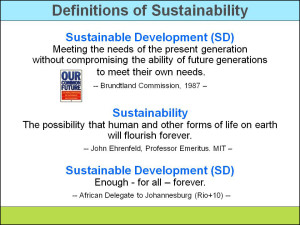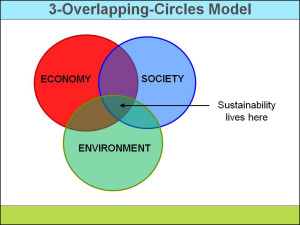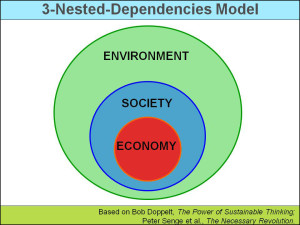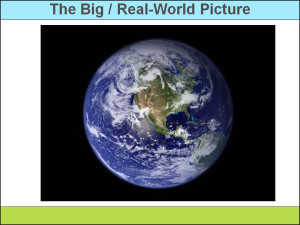3 Sustainability Models

As sustainability champions, we are sometimes confronted by frustrated people who ask what we mean by “sustainability.” What they really want to know is sustainability’s relevance to them, their organization, or their community. Is it a threatening concept, or a friendly one? Or maybe it’s just a fancy, multiple-syllable word for something to which they are already paying attention, at least partially?
As we attempt to clarify others’ perceptions and misconceptions, it is helpful to have a few definitions and models in our toolkit to facilitate the discussion. The 1987 Report of the Brundtland Commission, Our Common Future, defined sustainable development as, “meeting the needs of the present generation without compromising the ability of future generations to meet their own needs.” To supplement that touchstone definition and others, here are three sustainability models that might help explain what a sustainable society looks like.
3-legged stool modelFor years, I have used the adjacent slide to illustrate the common three dimensions of sustainability: economic, environmental, and social / cultural. The 3-legged stool metaphor reinforces the three dimensions that are required for us to enjoy a high quality of life— and shows that society is unstable if one of them is weak. The downside of this metaphor is that the economic, environmental, and social legs look separate and equal.
Some people add a fourth leg / dimension: culture. I see culture as intertwined with the social leg, but organizations like Living Principles divide the social aspect into people and culture. They define the people dimension as, “actions and issues that affect all aspects of society, including poverty, violence, injustice, education, healthcare, safe housing, labor and human rights,” and the culture dimension as “actions and issues that affect how communities manifest identity, preserve and cultivate traditions, and develop belief systems and commonly accepted values.” Living Principles refer to the economy, environment, people, and cultures as sustainability “streams.” Others refer to three or four “pillars” of sustainability. Metaphors abound.
3-overlapping-circles modelThe overlapping-circles model of sustainability acknowledges the intersection of economic, environmental, and social factors. Depending on our mindset, we re-size the circles to show that one factor is more dominant than the other two. For example, some business leaders prefer to show the economy as the largest circle because it is the most important to their success and it makes their world go round.
They draw society as the second largest circle because that is where their customers and other important stakeholders live. The environment would then be the smallest because it is the most external to standard business metrics. Unfortunately, this model implies that the economy can exist independently of society and the environment—that the part of the red circle that does not overlap with the blue and green circles has an existence of its own. This large incongruity leads us to the next, more accurate model.
3-nested-dependencies modelIf you were to ask a maritime fisherman whether the devastating collapse of the cod fishery off the east coast of Newfoundland was an environmental disaster, a social disaster, or an economic disaster, he would say, “Yes.” The 3-nested-dependencies model reflects this co-dependent reality. It shows that human society is a wholly-owned subsidiary of the environment—that without food, clean water, fresh air, fertile soil, and other natural resources, we’re cooked.
It’s the people in societies who decide how they will exchange goods and services. That is, they decide what economic model they will use. Because they create their economies, they can change them if they find their current economic models are not working to improve their quality of life. To add another metaphor: the economy is the tail and society is the dog—not vice versa.
To be fair, the society-economy relationship is symbiotic. During the recent recession, the economic downturn had a significant impact on people’s quality of life. Good jobs are so important to a vibrant modern-day society that sustainability champions who portray the economy as subservient to society are sometimes accused of being naïve about how the “real world” works.
It might be useful to use the picture of Earth in the adjacent slide to remind some critics about the real “real world.” This defining photo shows water, atmospheric clouds, and land—the environment. The photo also reminds us of a stark reality—there is no umbilical cord going somewhere else; we must live within the carrying capacity of the planet. We can’t see them in the photograph, but clusters of people on land form societies within that larger environment. And, it’s those societies which decide how they will exchange goods and services within and between themselves—their invisible economies. The 3-nested-dependencies model reflects this reality.
Let’s return to the original question: what is the relevance of these models to companies and their journey toward becoming sustainable enterprises? We will explore that relevance in my next series of blogs. We’ll review the 5-stage sustainability journey that organizations take to become sustainable enterprises. Then, we’ll use the 3-nested dependencies model to: assess why today’s business paradigm is unsustainable; outline what a sustainable business model would look like; and show the key steps that companies take towards that more desirable state.
Stay tuned …
Bob
As usual, the above slides are from my Master Slide Set.
Please feel free to add your comments and questions using the Comment link below.









Comments are closed.